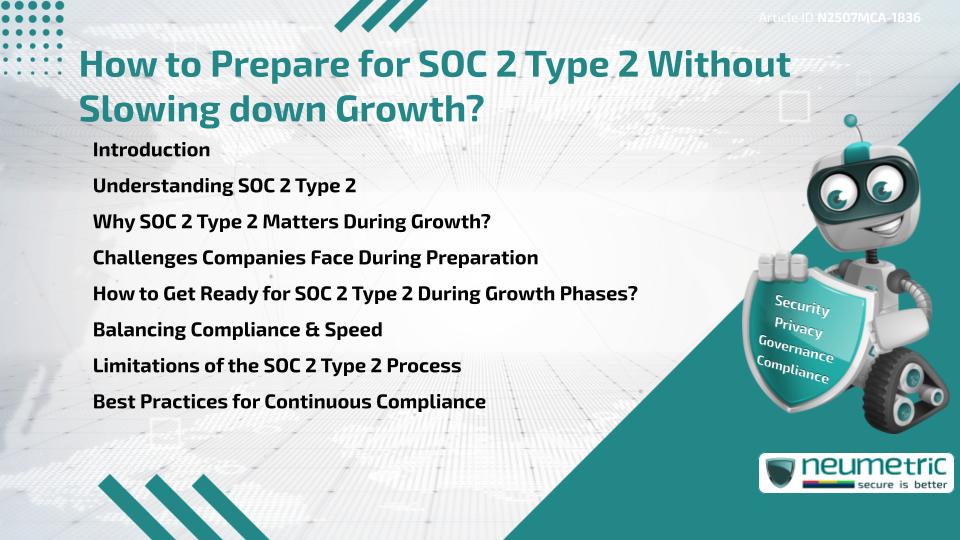Table of Contents
ToggleIntroduction
SOC 2 Type 2 is a benchmark of trust for service providers, especially in the technology & SaaS sectors. As businesses grow quickly, the question arises: how to prepare for SOC 2 type 2? Many founders fear that security Compliance will slow down product development or disrupt operations. This article explores how businesses can align their growth with SOC 2 Type 2 readiness, without trading off speed or innovation.
Understanding SOC 2 Type 2
SOC 2, short for System & Organisation Controls 2, is developed by the American Institute of Certified Public Accountants [AICPA]. Type 1 checks if controls are in place at a point in time. Type 2 goes further—it reviews how effectively those controls operate over a period, usually three (3) to twelve (12) months.
SOC 2 Type 2 focuses on five (5) Trust Service Criteria: Security, Availability, Processing Integrity, Confidentiality & Privacy. Each Organisation must define which of these apply based on its services.
Why SOC 2 Type 2 Matters During Growth?
Startups & scaling businesses often face vendor due diligence from enterprise Customers. Without a SOC 2 Type 2 report, sales discussions may stall or even fall apart entirely. Potential investors also see SOC 2 compliance as an indicator of a company’s operational discipline & maturity.
But how to prepare for SOC 2 type 2 when your team is already busy building & shipping product? The key is to integrate security & Compliance early so it becomes part of growth, not a blocker.
Challenges Companies Face During Preparation
Preparing for SOC 2 Type 2 can seem overwhelming. Common issues include:
- Lack of documentation for internal processes
- Weak Access Controls or inconsistent Employee onboarding
- Limited logging or monitoring of system activity
- Manual, error-prone Evidence Collection
- Misalignment between engineering & Compliance goals
How to Get Ready for SOC 2 Type 2 During Growth Phases?
So, how to prepare for SOC 2 type 2 effectively? It starts with planning & collaboration across teams.
Start with a Readiness Assessment
Before launching a full Audit, conduct a readiness assessment. This will help you identify which controls you already meet & where the gaps are.
Automate Evidence Collection
Use tools that automate logging, screenshots & Audit trails. This ensures you are not scrambling for proof during the review period.
Document Key Policies
Write clear, concise Policies around data access, onboarding, Incident Response & vendor management. Use templates if needed. The Center for Internet Security offers guidance on drafting such Policies.
Train your Team
Everyone must understand their role. Training developers, HR & support staff ensures controls are followed consistently.
Set Realistic Timelines
Do not rush. Plan for a minimum of six (6) months to gather & demonstrate evidence for a Type 2 Audit.
Balancing Compliance & Speed
If your question is how to prepare for SOC 2 type 2 without slowing growth?—the answer lies in using Compliance to build faster.
For example, having Incident Response procedures in place can reduce downtime. Implementing role-based access controls helps mitigate security risks, especially during periods of fast team expansion. Logging activities allow for quicker debugging.
Instead of viewing Compliance as overhead, frame it as performance insurance.
Limitations of the SOC 2 Type 2 Process
Although highly beneficial, SOC 2 Type 2 does have certain limitations::
- It does not test for every security Threat
- Evidence windows may miss some real-world edge cases
- Auditors may interpret criteria differently
- Not legally mandatory, so it may not satisfy all international Clients
To bridge these, companies often adopt ISO 27001 or HIPAA alongside SOC 2.
Best Practices for Continuous Compliance
SOC 2 is not a one-time goal. Once certified, you must maintain the controls year-round.
Assign Ownership
Each control should have an owner—ideally someone close to the function, like HR for hiring or DevOps for infrastructure.
Review Logs Regularly
Establish a consistent schedule—either weekly or monthly—to Audit system logs & security alerts.
Run Internal Audits
Internal reviews before the official Audit help identify gaps early.
Stay Informed
Monitor changes in Audit guidelines or Best Practices. The guidance offered by the American Institute of Certified Public Accountants [AICPA] serves as a useful starting point for understanding SOC expectations.
Takeaways
- Begin with a readiness assessment to avoid surprises.
- Automate wherever possible to reduce manual effort.
- Involve multiple teams & assign clear ownership of controls.
- View SOC 2 Type 2 as a strategic growth enabler, not just a requirement.
- Maintain documentation & controls continuously, not just before Audits.
FAQ
What is the first step in how to prepare for SOC 2 type 2?
Start with a readiness assessment to identify your current Compliance posture & control gaps.
Do startups need to worry about how to prepare for SOC 2 type 2?
Yes, especially if you are targeting enterprise Clients or handling sensitive Customer Data.
Can a company scale & still focus on how to prepare for SOC 2 type 2?
Absolutely. Integrating Compliance tools & clear Policies early helps scale securely without delays.
How much time is required to prepare for SOC 2 Type 2?
Generally it takes six (6) to twelve (12) months but also depends upon existing processes & controls.
Are external consultants necessary for how to prepare for SOC 2 type 2?
Not always. Some companies manage it in-house using automation platforms & internal Policies.
Does the Audit process disrupt product development?
Not if you plan ahead. Many tools work in the background & reduce friction for developers.
What documents are required when learning how to prepare for SOC 2 type 2?
Common documents include access Policies, Incident Response plans, Employee Training records & vendor Risk Assessments.
Is SOC 2 Type 2 more important than Type 1?
Yes, Type 2 proves your controls actually work over time, offering more credibility to Customers.
Need help?
Neumetric provides organisations the necessary help to achieve their Cybersecurity, Compliance, Governance, Privacy, Certifications & Pentesting goals.
Organisations & Businesses, specifically those which provide SaaS & AI Solutions, usually need a Cybersecurity Partner for meeting & maintaining the ongoing Security & Privacy needs & requirements of their Clients & Customers.
SOC 2, ISO 27001, ISO 42001, NIST, HIPAA, HECVAT, EU GDPR are some of the Frameworks that are served by Fusion – a centralised, automated, AI-enabled SaaS Solution created & managed by Neumetric.
Reach out to us!


